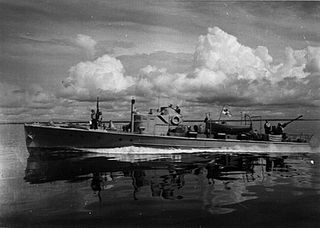Related Research Articles

An ensign is the national flag flown on a vessel to indicate nationality. The ensign is the largest flag, generally flown at the stern (rear) of the ship while in port. The naval ensign, used on warships, may be different from the civil ensign or the yacht ensign. Large versions of naval ensigns called battle ensigns are used when a warship goes into battle. The ensign differs from the jack, which is flown from a jackstaff at the bow of a vessel.

The Finnish Navy is one of the branches of the Finnish Defence Forces. The navy employs 2,300 people and about 4,300 conscripts are trained each year. Finnish Navy vessels are given the ship prefix "FNS", short for "Finnish Navy ship", but this is not used in Finnish language contexts. The Finnish Navy also includes coastal forces and coastal artillery.

Ilmarinen was a Finnish Navy Panssarilaiva. The unit was constructed at the Crichton-Vulcan shipyard in Turku, Finland, and named after the mythological hero Ilmarinen from the Finnish national epic, the Kalevala. Ilmarinen was the flagship of the Navy from 1 May 1933 until her sinking on 13 September 1941.

The Baltic Fleet is the fleet of the Russian Navy in the Baltic Sea.

The Baltic Sea Campaigns were conducted by Axis and Allied naval forces in the Baltic Sea, its coastal regions, and the Gulf of Finland during World War II. After early fighting between Polish and German forces, the main combatants were Germany and Finland, opposed by the Soviet Union. Sweden's navy and merchant fleet played important roles, and the British Royal Navy planned Operation Catherine for the control of the Baltic Sea and its exit choke point into the North Sea.

The Type UB III submarine was a class of U-boat built during World War I by the German Imperial Navy.

The Type UB I submarine was a class of small coastal submarines (U-boats) built in Germany at the beginning of the First World War. 20 boats were constructed, most of which went into service with the German Imperial Navy. Boats of this design were also operated by the Austro-Hungarian Navy and the Bulgarian Navy. In the Austro-Hungarian Navy, it was called the U-10 class.

Turunmaa was a Finnish gunboat built in 1918. She served in the Finnish Navy during World War II. The ship was named after Turuma, a type of frigate designed for use in shallow waters of the archipelago and served in the Swedish Archipelago fleet in the late 18th century. The frigates had in turn been named after the region of Finland.

S2 was a Finnish Sokol class torpedo boat that had been seized from the Russians after the Finnish Civil War 1918. She sank during a fierce storm on 4 October 1925, taking with her the whole crew of 53.

The American Holland-class submarines, also AG class or A class, were Holland 602 type submarines used by the Imperial Russian and Soviet Navies in the early 20th century. The small submarines participated in the World War I Baltic Sea and Black Sea theatres and a handful of them also saw action during World War II.

VMV-class patrol boat was a series of Finnish patrol boats, which served with the Finnish Coast Guard and the Finnish Navy during World War II.

The Savoia-Marchetti SM.62 was an Italian single-engine maritime patrol flying boat produced from 1926. It served with the Regia Aeronautica and with a number of foreign users, and was licence-produced in Spain and the Soviet Union. Some of the Spanish aircraft were still in service during the Spanish Civil War

SM U-118 was a type UE II mine laying submarine of the Imperial German Navy and one of 329 submarines serving with that navy during World War I.

The Type UE II submarines were a class of submarines built by the German Empire during World War I as long-range mine-layers.
The following events occurred in February 1918:
The following events occurred in March 1918:
The following events occurred in May 1918:

The Zhuk-class patrol boat, also known as Project 1400M "Grif", is a small border patrol vessel of less than 40 ton displacement built in the Soviet Union and later in Ukraine. Over 300 boats were built between 1969 and 1991. Out of those, 110 were sold to 23 other countries. Exact numbers are unknown, but they were widely exported by the Soviet Union in addition to use in home waters as harbor patrol. The vessels were excellent for this task thanks to a cheap design for mass production. With only a single simple radar unit and manually-aimed machine guns, they made ideal patrol boats. The dissolution of the Soviet Union in 1991, and the abolition of its primary user the, KGB Maritime Guard, it was taken over by the Russian Federal Coast Guard. By 2007 only 15-20 remained in service with the Russian Navy.
The following events occurred in April 1918:
The D-3 was a Soviet motor torpedo boat (MTB) design built before and during World War II. One boat was captured by the Finns and operated by them before had to be returned to the Soviets after the Moscow Armistice in 1944. After the war, two vessels were exported to Poland in 1946.
References
- ↑ Auvinen, Visa (1983). Leijonalippu merellä[Lion flag at sea] (in Finnish). Pori, Finland: Satakunnan Kirjapaino Oy. p. 63. ISBN 951-95781-1-0.